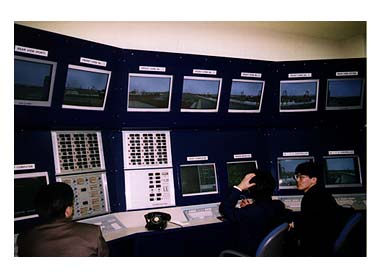
Gary Lauer and TJ.


NSG Celebrated Record-Breaking Q3 Results
Nihon Silicon Graphics (NSG) had cause for celebration at the end of Q3: a 100-million dollar goal reached. Tom Jermoluk and Gary Lauer were on hand at the May 8 party celebrating the team's success.

|
"I congratulate this great achievement for NSG employees and I hope this momentum will carry over to fiscal year 1997," TJ told the group.
NSG was established almost ten years ago, in 1987, with a small, four-person office. Today, headquarters are located in Tokyo, with divisions in Nogoya and Osaka, and the number of employees has grown to 271. (Except for one American, all are from Japan.) Revenue has skyrocketed, with NSG serving Japanese businesses primarily in the manufacturing, video game, and entertainment industries. The key to NSG's success has been to set objectives and reach them, by embodying SGI's spirit of cooperation.
"Our milestone for a long time has been to attain $100 million in one quarter. After ten years, we finally achieved this goal in this landmark quarter," said Yasuhisa Arakawa, President of NSG. "Our dream came true!"
Sayaka Terui, NSG

Tokyo University Sends Media Sailing
Last September NSG closed a $900,000 sales win with Tokyo University of Mercantile Marine for SGI technology including an Onyx InfiniteReality, Indigo2 and Indy systems, to create a mission ship maneuvering simulator that creates with precise accuracy and a ship's real maneuvering environment.
On May 13 the university unveiled its ship maneuvering simulator at Yokohama Bay for the press, taking them on a 15 minute virtual sail under the command of a sea captain. A 23-foot arch screen and front projection system were used for the demonstration.
"Other simulators we've used can't compete with the high quality images the Onyx creates," said Professor Hiroaki Kobayashi, who spearheaded the decision to use SGI's technology to create the new simulator. "When we maneuver the ship we can see harbor facilities and the real-time images of other ships. This realism of maneuvering is extremely useful."
Under Professor Kobayashi's direction, the simulator will be used for research and training. "The simulator will be used to train students in maneuvering during the night, in low visibility situations, and during rough seas," he explained. "It's very important to experience these situations in as realistic an environment as possible, to learn how not to panic. It also allows us to study safety measures and the cause of marine casualties."
Established in 1949, with a student body of 872, Tokyo University of Mercantile Marine is a well- established authority in the shipping industry, not only in Japan, but throughout Asia. This relationship and the successful demo of the simulator will be a great head start for NSG in establishing inroads with shipping companies, other training institutions, government, and further ties with the entertainment industry.
Sayaka Terui, NSG
WebFORCE Mega Tour is Mega Hit

Thanks to the combined forces and smooth teamwork of SGI's Asian subsidiaries and Digital Media Systems (DMS), the WebFORCE Mega Tour -- which touched down in May in Korea and Japan -- was a mega-hit, wowing thousands of web enthusiasts with SGI's Internet and Intranet visual computing solutions.
The team traveled to Seoul for the first leg of the tour, then on to Japan's Chiba Prefecture, for three days at the Nihon Convention Center. Here SGI was a major attraction at Internet World 1996 Japan -- a worldwide Internet trade show. Of the 10,000 people in attendance, 2,000 registered at the SGI booth.
Visitors were particularly impressed by SGI's ability to create rich Web site content using Alias/Wavefront software and Silicon Junction was also enthusiastically received as an example of a very creative Intranet. The ability to showcase SGI solutions and products to customers clearly made the tour a success.
Yutaka Aiko, NSG